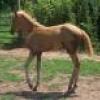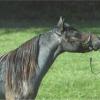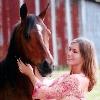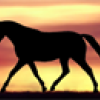Okay, all you Welsh Pony breeders/lovers...
Forums
Re: Okay, all you Welsh Pony breeders/lovers...
Amen NZ...how many times have you seen people breed a "refined" pedigreed stud to an equally "refined" mare only to decrease bone and endurance in the "too refined" foal, or a "dishy" head to a "dishy head" only to develop nasal issues in an overly dish faced foal....you see where I am going.
I think moderation should be used when breeding any animal (dogs, cats, horses, etc) because any defect in the foundation animals will only be amplified in the offspring. This amplification is multiplied when the animals are related as in linebreeding and especially inbreeding....
Re: Okay, all you Welsh Pony breeders/lovers...
Boy... They don't expect much, do they? LOL.
This is going to be a 5 hour talk, right? :rofl I'll be there again, and look forward to seeing you again.
Now when you ask about the different sections and restrictions... How far back? One of my mares has a B in the pedigree, so it's really opening a can of worms... Right now, the only way to get an A is by 2As. B= A to B or B to B
C= A to D or C to C, and Ds are C to D or D to D. This last one, I've not looked into all that much, but I think it just depends on size?
Would you like me to post your queries on the Welsh pony board to get you some ideas/material?
Re: Okay, all you Welsh Pony breeders/lovers...
Also, as far as the standards go from the East to West coast... The standard is the same... :booty
But... the east coast breeders like the leggier hunter types vs the CA. people tend to like the flippy toe movement and more bone. I say this leaving the Bs out of it.
One thing I'd love to see you address is the funky way people have started standing the ponies up... With their heads/necks straight up so they look sway back. I think they are going for the deep girth look, but man! I hate seeing a 12 inch dip behind the withers! If this is what wins, you can imagine what people will start breeding into the ponies... I'll see if I can find some examples...
Re: Okay, all you Welsh Pony breeders/lovers...
http://www.blaengwen.com/" onclick="window.open(this.href);return false;
http://www.caederwenstud.com/" onclick="window.open(this.href);return false;
I just don't see how this is attractive...
Re: Okay, all you Welsh Pony breeders/lovers...
Interesting topic. One thing that has happened in the last 50 years for definate is the height restriction changing on D's I think it may even have been removed completely. The sec D (to my mind) is supposed to be a big pony 13.3-14.2 sort of size with type and bone, not a 15.2hh monster with no bone.....oops rant mode starting. Also the sec A particularly was always supposed to have a small muzzle and broad forehead but a 'pony' face not look like an arab thats trying to be a deer. :)
Re: Okay, all you Welsh Pony breeders/lovers...
Those Cob ponies were AWFUL!!! Absolutely disgusting. I saw this time and time again when we were showing Victor...he was beaten by animal that flailed around the ring and no farmer in his right mind would ever have put his leg over, whilst Victors extended trot had to be seen to be believed!!
BUT Victor had a plain head and a level topline, very old fashioned.
I would like to see a World Standard for all the sections, with the height fixed and the type left up to the individual. At the end of the day the type is fixed by what is winning in the show ring, as with everything else!!
Section C and D go by height, surely, not what is crossed to what??
BXD would normally go C, which I completely disagree with, but is legal, but of course it takes away the bone and, without bone, what is a Cob??
A word here about Cobs...those on Andreas's website examples are [i]not[/i] Cobs, they are "Punches" like the Suffolk used to be, and that is [i]not[/i] what a Welsh Cob should look like.
Unfortunately it is what is winning at the moment, but don't worry, just stand still, keep breeding what you like and wait. It will all change again in a couple of years time!!
Sec A should not be over 11.2hh, mares I prefer at 11.00hh but they are slowly getting bigger and bigger, I have noticed.
A few years back I could have got a 10hh sec A easily, for my breeding programme, now I can't find one anywhere!
There is no height limit for Sec D here, which is daft beyond imagining. A Cob is a heavy, weight carrying, animal between 12.3hh and 14.3hh(Although I have to say that I consider Exmoors to be Cobs and they are quite a bit smaller, but since they are "special" I think they have exemption!)
The best Cob mare I ever owned was 12.3hh and a real, load bearing, Cob Pony, no doubt whatsoever, bred in the purple, too.
She was A X small D.
Re: Okay, all you Welsh Pony breeders/lovers...
Excellent, people, excellent! Please keep discussing amongst yourselves...it's very educational for me to hear your comments and even complaints. I learn the most about these topics by simply being a fly on the wall. ;)
So, to clarify a few points and maybe continue to subtly point this discussion in the direction I'm interested in...
As far as breeding within the sections, I'm most interested in what the rules are right now, but if you guys know what "used to be" allowed, I'm interested in that too, and how it's changed the type of horse in each section. So...there used to be a height limit on D's of 14.2, but now there is no limit, leading to bigger and bigger horses, yes? It sounds like maybe the rules are different between the US and the UK, because rabbit mentioned that a B x D can be a C, but Andrea did not list that?
Yes, please post on your boards, Andrea. I'm very interested in photos that illustrate what ponies in the different sections looked like 50 years ago (what was popular and/or winning) versus what is being bred for today, along with people's impressions of how it's changed. Judy Herbert is going to assist me with some of this as well.
I know that "technically" the standard is the same for all Welshes, but that the type people are selecting for is different here versus in the East. Do you have any photos, or maybe websites from "winning" barns on the East coast versus here? Then I could just look at the photos and figure out the differences.
Rabbit, in your mind, what should a section D look like? It seems like they all look like those photos Andrea posted...and why does B x D take away the "bone" of a horse?
Re: Okay, all you Welsh Pony breeders/lovers...
[quote="Andrea"]http://www.blaengwen.com/
http://www.caederwenstud.com/" onclick="window.open(this.href);return false;
I just don't see how this is attractive...[/quote]
ewww....i have never seen anything like those! I take that back, my friend's oldenburg looked like that as a filly because she was SO bumhigh, but she grew up and is lovely....that is just....gross.
Re: Okay, all you Welsh Pony breeders/lovers...
[quote="critterkeeper"]That is just so off-putting that it's a miracle anyone would want to breed those. I must confess - when I first looked at those pixs Andrea posted, my very first thought was "and they talk about the Quarter Horses..."[/quote]
Aside from the whole disease part, they are as grotesque as the HH horses.
Re: Okay, all you Welsh Pony breeders/lovers...
[quote="Monsterpony"]I think it would be interesting to compare side to side photos of the champion horses from 50 years ago with photos of the top show horses today to really illustrate the changes in style/conformation.[/quote]
[size=150]BRILLIANT[/size]!!!!! "[i]A picture speaks a thousand words[/i]."
I think an example like what you suggest could be a very eye-opening experience! :shock:
Re: Okay, all you Welsh Pony breeders/lovers...
What made me think of it was an article on Tennessee Walkers showing "big lick" horses of the 1940s and 1950s and then those that are winning in the present day...now THAT is eye opening.
Champion walker 1945
http://www.walking-horse.com/champion/1…" onclick="window.open(this.href);return false;
Champion walker 1995
http://www.awalkinghorseranch.com/image…" onclick="window.open(this.href);return false;
See the difference?
Re: Okay, all you Welsh Pony breeders/lovers...
Oh wow! No wonder TWH people seem to always have breast plates on their saddles...what's the purpose of having a sloped-backed gait like that? These horses aren't expect to run over the tops of sheep like I've had it explained to me why GSDs now have that look... :BH :BH (so why don't collies, borders, and other working sheep dogs?) :BH :BH :BH :BH :BH
Diane
Re: Okay, all you Welsh Pony breeders/lovers...
On the heights of the different sections...
I was talking with another breeder at a show and were talking about an A that was pure A, no B blood. The pony was 12.1 and we were talking about why the ponies in the Americas were tending to be taller. And other then breeding taller to taller ponies we thought that nutrition probably had a lot to do with it as well.
Since we feed our ponies instead of letting them eat what they can off the hills, I would expect them to reach their full height potential.
Of course the introduction of the B to A blood a while back probably had something to do with height as well
Re: Okay, all you Welsh Pony breeders/lovers...
[quote="Andrea"]...other then breeding taller to taller ponies we thought that nutrition probably had a lot to do with it as well.
Since we feed our ponies instead of letting them eat what they can off the hills, I would expect them to reach their full height potential.
[/quote]
I believe this is the same thing occuring with the Paso Fino horses in America; better feed AND people breeding tallest to tallest in pursuit of the 15h horse so it would be more appealing to taller/larger American riders. My little mare is AT LEAST 3h smaller than my friend's Paint gelding, but she is smmmoooOOOoooth and I can lap her great big guy in barrel weaving.
Re: Okay, all you Welsh Pony breeders/lovers...
[quote="Heidi"][quote="Andrea"]...other then breeding taller to taller ponies we thought that nutrition probably had a lot to do with it as well.
Since we feed our ponies instead of letting them eat what they can off the hills, I would expect them to reach their full height potential.
[/quote]
I believe this is the same thing occuring with the Paso Fino horses in America; better feed AND people breeding tallest to tallest in pursuit of the 15h horse so it would be more appealing to taller/larger American riders. My little mare is AT LEAST 3h smaller than my friend's Paint gelding, but she is smmmoooOOOoooth and I can lap her great big guy in barrel weaving.[/quote]
The trouble with this is that bigger is not always better - the smaller compact Pasos are mostly better built from what I have seen.
Re: Okay, all you Welsh Pony breeders/lovers...
[quote="NZ Appaloosas"]Oh wow! No wonder TWH people seem to always have breast plates on their saddles...what's the purpose of having a sloped-backed gait like that? These horses aren't expect to run over the tops of sheep like I've had it explained to me why DOGs now have that look... :BH :BH (so why don't collies, borders, and other working sheep dogs?) :BH :BH :BH :BH :BH
Diane[/quote]
Because they don't run over the tops of sheep.
Neither do GSDs, nor have they ever done.
This skill is unique to the NZ Huntaway.
Occasionally you will get a WSD that will do it, but it is unusual, and I am assuming that it was this sort of behaviour that was deliberately bred into the Huntaway.
Now come on, Diane, [i]you[/i]should know that!!!!
The GSD's are like that because of the way they were stood out.
Eventually people started breeding for roach backs and the resultant cow hocks, so that they would stand in that exaggerated pose.
If you look at pictures of the pre-war and immediately post war GSDs, they had level top lines and were sound dogs.
Today, the dog that won Crufts was SO unsound there was actually a public outcry in the media, leading to the RSPCA coordinating with the Kennel Club to do something about it.
As I understand it (although it may have been changed again by now) all Championship shows were withheld until a plan of action was put before the KC and agreed upon!
Yay, the KC actually [i]did[/i]something.
We are still waiting for them to do something about the Cavalier King Charles Spaniel, though.
And there are NO mandatory health screening tests for breeding bitches or dogs.
The Dobe Club [i]asked[/i]fr them and was told it was not practical!!!
Under EU law a pup that is form two registered parents [i]has[/i]to be accepted for registration, but I think serious health issues might be accepted as causing an exception.
Re: Okay, all you Welsh Pony breeders/lovers...
[quote="Andrea"]On the heights of the different sections...
I was talking with another breeder at a show and were talking about an A that was pure A, no B blood. The pony was 12.1 and we were talking about why the ponies in the Americas were tending to be taller. And other then breeding taller to taller ponies we thought that nutrition probably had a lot to do with it as well.
Since we feed our ponies instead of letting them eat what they can off the hills, I would expect them to reach their full height potential.
Of course the introduction of the B to A blood a while back probably had something to do with height as well[/quote]
Not really, after all it did not happen with the Arabs, we fed them just fine, but they did not turn into the giants that they are fast becoming til they crossed the pond seriously.
I think the Americans have always had a thing for "bigger is better" and it is dead easy to breed bigger
The hardest thing is to keep the ponies in the standard!!
Re: Okay, all you Welsh Pony breeders/lovers...
RF, can you post some links or pics to ponies that you think fit the breed standard as they were meant to?
I love Frodo's look and when I think of Welsh, I think of his pony head. But... That's not the head of a Welsh from way back... But I don't like the coarser heads or the araby heads...
Re: Okay, all you Welsh Pony breeders/lovers...
Another important thing you could talk about is people who choose breeding animals knowing they have faults such as bite problems. There is one stallion competing now that both the trainer and owner know he has this issue and yet they still will use him for breeding and I doubt they will disclose it to the mare owners. It's sickening to me.
And not all mares are breeding animals!









Re: Okay, all you Welsh Pony breeders/lovers...
I'm not a Welshie person, but man-oh-man, what a great opportunity to push the idea that people need to go back to breeding type to type rather than flavour of the month! I think a large problem with any breed today is that we've got breeders who really do not understand conformation, nicks, etc., and are just not "stock" persons any more, but rely on pedigrees, show wins, etc. While I do prefer a proven horse to an unproven horse, I'm not gonna only rely on that information...I need to know that a stud's conformation WILL actually complement and/or improve the mare.
Diane